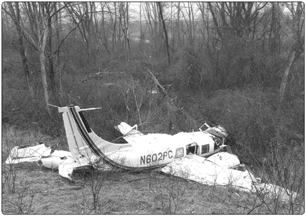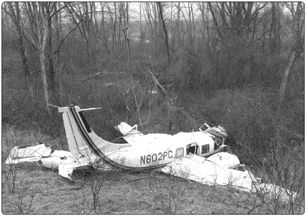
By Carole Jewett
A small plane crashes in a remote area, with no hope of rescue for several days. The survivors know basic survival techniques but have only rudimentary first aid skills. How does the pilot in command sort, assess and treat injuries when the first-aid kit just went up in smoke? What kind of leadership qualities will that person need? What ethical dilemmas will the leader likely face during the ordeal? A pilot who crashes in a remote area must be prepared to provide pre-hospital care without support from or contact with a physician.
There are many books and training programs about survival after a small-plane crash landing-how to find water, how to prepare a shelter, build a fire or signal for rescue. But one aspect of survival frequently overlooked is first aid in a remote and hostile environment. This type of first aid involves assessing and treating injuries to you and your passengers-possibly for an extended period-while awaiting rescue. While this article alone wont accomplish that goal, it will at least demonstrate the need for training and provide some ideas on how pilots can prepare and equip themselves.
Assessing Injuries
Any assessment of injuries must begin with the basics, conveniently known as the ABCs-for airway, breathing and circulation. Using this checklist, we assess and fix any immediate life-threatening injury. Examples can include a closed or compromised airway, ensuring the victim is breathing and has a heartbeat, and is not hemorrhaging.
Once the three items on this checklist are complete, we move on to a more thorough assessment of the victims injuries. Paramount in this process is being mindful of the potential for spinal injury: Keep the victim as motionless as possible throughout the examination until you are certain no spinal cord injury exists. Try to keep the victims head aligned with the midline of his or her body at all times.
Start at the top of the victims head and work your way down, using both hands, looking at and feeling the body. One of the things youre doing here is looking for blood. Carefully move the flat of your hand under the neck, back, buttocks and legs, frequently checking your hand for blood. Keep in mind the old truism from emergency rooms that the worst injury will be in an area of the body least exposed.
Move all the way to the victims toes. If your examination finds blood at any point, stop and expose the skin whenever possible, preferably by removing clothes, not cutting them. If you must cut the clothing, tape them back together after the exam to retain warmth. (You do have a roll of duct tape in your airplanes equipment, right?) Generally, I recommend leaving footwear on the feet; once removed, they will be difficult to replace due to swelling.Also, if there is a fracture, the shoe or boot will serve as a splint.
This part of the assessment is not stop and fix: If you discover a fracture or laceration but its not hemorrhaging, dont stop. Continue with the exam until you have inspected the entire body-there may be something critical just beyond the next joint.
Now that the top-to-bottom examination is complete, its a good time to try to get some medical history: Does the victim need any personal medications for conditions like diabetes, angina or seizures? Were the medications aboard the plane and can they be retrieved? It might be a good idea to learn about any such conditions among your passengers before taking them on a cross-country flight.
Triage And Treatment
You have three passengers. You managed to get everyone to safety, despite a severe gash on your upper leg that is bleeding heavily. Your co-pilot is unconscious and bleeding from a scalp wound. An elderly passenger is gasping for breath and rubbing his left arm. His wife is sitting on the ground, clutching her elbow and screaming, Im hurt, Im hurt! Whom do you treat first?
Triage, a French word that means screening, has become associated with the sorting and allocating of medical care in the field, based on need and the available resources. In this case, a primary resource is the caregivers knowledge and ability to treat others.
There are several types of sorting categories, depending on the medical facility or group performing triage. For our purposes, however, there are only three: immediate, for the life-threatening injuries); later (for broken bones and lacerations) and last (for everyone else). Remember: You cannot treat and take care of your passengers if you are suffering from life-threatening injuries yourself. So…who gets treated first? Thats right-you do. Then, you attend to the head injury, the possible heart attack and, last, the hysterical woman with a possible dislocated elbow.
One tool we can use to help decide who needs what and when is taking the victims vital signs. These include the rate and quality of the heartbeat and respirations, the temperature and color of the skin, and the relative size of the eyes pupils. Together, these vital signs can be thought of as the bodys engine instruments and should be used to help us decide if the victim is going into shock, or if the airway or lungs have been compromised.
But the most important instrument of all is the level of consciousness, or LOC. The LOC can be evaluated by determining if the person is alert and oriented to time and place, only responds to voice, only responds to pain, or does not respond at all.
Another technique worth mentioning is clearing the spine. In urban first aid, we expect an ambulance to arrive within 10 to 20 minutes, and were taught to keep the victims head and neck immobilized and wait for the paramedics. In wilderness first aid, it may be days before rescue and you wont want to completely immobilize someone if they dont need it. So, youll need to conduct a more formal spinal assessment, one based on evaluating neurological function, which will tell you if a victims spinal cord has been injured.
The examination used to clear the spine asks questions such as: Was the injury severe? Is the victim sober? Is the victim distracted from your questions and probing by pain or emotional distress? Is there pain, tingling or numbness in the extremities? Is there pain or tenderness when you touch along the spine? Can the victim move his/her head without pain?
If they pass this exam, they can get up and move around as well as they can tolerate. If not, keep them immobilized.
In-Flight Emergencies
What constitutes an in-flight medical emergency, and what can you do to help while maintaining control of the aircraft? The answers depend on whats going on with the patient, but any situation becomes an emergency when the person becomes confused, lethargic or unconscious. Other signs of a medical emergency can include sudden and severe pain, shortness of breath, sudden weakness, difficulty in speech or a seizure.
The first thing to do should be obvious: Fly the airplane! Next, ensure the distressed passenger cant interfere with the controls. Engage the autopilot and move the passenger seat back; if necessary, manipulate the seat adjustment lever, pitch the airplane up and let gravity do the work. If the passenger is unconscious, lower the seat back no more than 45 degrees while ensuring the head is supported and there is an adequate airway. Of course, if there are other passengers who can help, let them help stabilize the patient while you concentrate on flying the airplane.
If there are no other passengers aboard who can help, do not try performing CPR, even with the autopilot engaged-youll be wasting precious time. Instead, concentrate on declaring an emergency and making sure ATC knows youll need an ambulance on landing. If you beat the ambulance to the airport, dont wait for it before starting CPR.
Once on the ground, pull off the runway onto grass or a taxiway, shut down, pull the passenger out of the airplane and onto the ground, assess the ABCs discussed earlier and perform CPR as necessary. Let the ambulance come to you. While waiting on an ambulance and if the airplane is equipped with oxygen and the patient is conscious, administer O2 to the patient until help arrives.
Ethical Dilemmas
Ethical dilemmas in medical care traditionally apply only to health care professionals. However, many of the same issues can arise in the wilderness setting for someone who is called upon to administer first aid without benefit of medical training, advice, guidance or equipment. The combination of limited skills, limited resources and the likelihood of a prolonged delay before rescue brings up several considerations.
For example, the decision of what goes into your first-aid kit, how well-trained you are to use it, and how well you can improvise with the resources available determines the limits on treatment you are willing to accept for yourself and your passengers. On the other hand, no matter what first-aid supplies you carry or how well trained you are, limits to available care still exist. So, just as you should do when making decisions when airborne, know your limitations-an untrained persons capabilities and their decision-making abilities will vary widely.
The responder must weigh the chance of performing a procedure that may benefit the patient against the possibility of doing further harm. Sometimes, the person feeling responsible for the others may take steps that will place the survivors at further risk. For example, do you abandon your passengers to go in search of food, water or rescuers, or stay, knowing that a potential rescue may be delayed? What if you are the only one with first-aid or survival skills? Of course, there are no easy answers to these questions, only more questions.
Conclusion
This article is by no means a complete course in wilderness first aid. For that, youll need to sign up with a local ski, climbing or hiking club, as one example. Meanwhile, think about what equipment you want to carry and play te what-if game on every flight.
Wilderness survival is very much like getting to Carnegie Hall-it takes practice.
Also With This Article
“Pyramid Of The Seven Gets”
“First-Aid Kits Vs. Survival Kits”
“The Pilots Leadership Role”
-Carole Jewett ([email protected]) is a trauma nurse and Private pilot who trains pilots in wilderness first aid.




